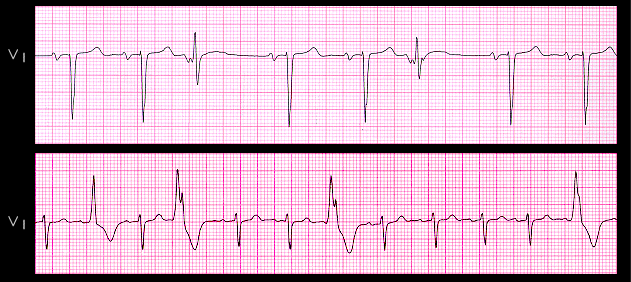The interval between a non-premature beat and the premature beat that follows it is referred to as the “coupling interval” and may be fixed, i.e. constant, or variable. A fixed coupling interval suggests that re-entry is the cause of the premature beat, whereas a variable coupling interval suggests that enhanced automaticity of an ectopic focus may be the more likely mechanism.

An example of each is shown here. The two premature beats in the upper tracing have identical coupling intervals of 0.6 seconds, indicating that they are “fixed” to the preceding sinus beat, whereas the coupling intervals of the four premature beats in the lower tracing are variable, ranging from 0.40 to 0.56 seconds. Note also in the lower tracing, that the intervals between the premature complexes of 0.96, 2.0 and 2.9 seconds, are approximate multiples of 1.0 seconds, suggesting an automatic focus with a discharge rate of close to 60. This is referred to as a “parasystolic focus” and the phenomenon of ventricular premature beats with variable coupling intervals, and with inter-ectopic durations that are multiples of a common interval, such as those demonstrated here, is labeled “ventricular parasystole”.
The coupling interval of atrial premature beats may also be fixed or variable, and atrial parasystole, having the same characteristics as ventricular parasystole may also occur.
